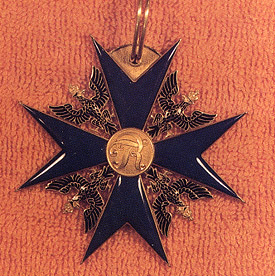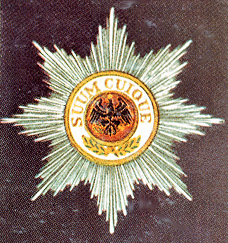


The Order of the Black Eagle was instituted on January 18, 1701, by Frederick I, who crowned himself king, in Königsberg, the capital of the Baltic duchy. It's legend is "Suum Cuique."
It is reported that the Order of the Black Eagle was founded for thirty knights. These knights had to prove their noble descent. However, after 1848, this proof was abandoned. It was then was conferred on nobility of the time. The Grand Cordon (sash) is orange and is worn over the left shoulder.
Stars, of this order, vary in size. The older threaded embroidered stars used to be rather large. Stars of reduced size were made for the children of royal families.
We know that Frederick William gave Saxon minister, Graf Brühl the Order of the Black Eagle.
Frederick the Great gave the Order of the Black Eagle to James Keith, a Jacobite follower of the "Old Pretender" of the Royal Stuart Line. Keith had lost his Scottish estates after the Jacobite revolt against George I in 1715. Keith went into exile and rose to the rank of general in the Russian service, before becoming a member of Frederick the Great's coterie (MacDonagh, Frederick the Great, 194).
The Order of the Black Eagle was handed out to those who reached the rank of lieutenant-general, and officers were decorated and promoted, on the battlefield, like Prince Maurice, who elevated to field marshal after the battle of Leuthen. It was Prussia's highest decoration and it was in one class only. A Prussian soldier was to have "blind obedience and steadfastness in the face of death" (Behrens, Society Government, and Enlightenment, 182-183.).
On February 18, 1762, Frederick the Great gave Czar Peter the Order of the Black Eagle after he came to power as Peter III. Peter III was invested on March 23, 1762, in Saint Petersburg. There was an accompanying feast with toasts and 150 cannon salute.
Later Frederick heard that Peter III had been deposed by his wife, Catherine (Catharine the Great), on June 28th and possibly murdered on July 6th. It was said he died of "severe colic brought on by piles." Frederick made the remark: "We know how dangerous that illness is in Russia." this was a tongue-in-cheek reference to his disbelief (Frederick the Great, Testament politique, 221).
Robert Keith, an earlier recepient of the Order of the Black Eagle (see above) reported these events on July 18th. He remarked that "Peter had many excellent qualities and never did a violent or cruel action in the course of his short reign."
The Cross of the Order of the Black Eagle has a navy blue enamelled cross with enamelled black eagles between. Another variation has four royal crowns.
 ...
... 
Sources:
Ball, Robert W.D. and Paul Peters. Military Medals, Decorations & Orders of the United States and Europe. Atglen, PA.: Schiffer Military/Aviation History, 1994.
MacDonogh, Giles. Frederick the Great: A Life in Deed and Letters. New York: St. Martin's Press, 1999.
Mericka, Vaclav. Orders & Decorations. 20,27,29,31,49.
RELATED SUBJECTS:
Frederick William I the Soldier-King of Prussia
